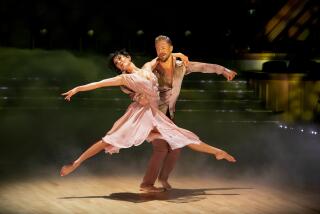‘Dancing’ with the stars? More like recuperating with them.

- Share via
The show is about dancing, for heaven’s sake. How dangerous can it be? Consider this: Before Season 8’s “Dancing With the Stars” premiered last week, two celebrity contestants were already on the injured list and off the program.
“Access Hollywood” co-anchor Nancy O’Dell suffered a torn meniscus, requiring surgery, and singer Jewel sustained fractures in both tibiae (shinbones). But wait, there’s more: In the current cast, actor Gilles Marini reported a left shoulder injury and Apple co-founder Steve Wozniak has injured his foot, according to an ABC spokesperson, and was recently photographed wearing a removable cast. And ballroom may have gotten the best of Steve-O, survivor of innumerable outrageous “Jackass” stunts. In a statement he released last week, dancing may be responsible for torn muscles causing inflammation and pinched nerves in his back.
They join a growing and almost alarming list of the show’s previous celebs-turned-dancers who have been injured during practice, rehearsals or taping: Olympic volleyball player Misty May-Treanor ruptured her Achilles tendon, actor Cristián de la Fuente ruptured his biceps, actress Susan Lucci sprained her ankle, and singer Marie Osmond fainted on stage.
As Jewel hobbles on crutches and May-Treanor continues to rehab, viewers are left wondering what the heck is going on. Injuries aren’t racked up this fast on “Survivor,” with its camping and wilderness shtick, or “The Biggest Loser,” which looks to be torturing the morbidly obese. This is only ballroom dance, right?
The “only” is the rub. Don’t be blinded by the blinged-out costumes. The discipline is far more demanding -- both physically and mentally -- than most people realize, even for the fittest competitors. Champion dancers make it look effortless, but the audience never sees the long years of blood, sweat and training.
“A lot of people come into the sport and think it’s so easy, that anyone can do this,” says Efrosyni Iosiphidis, a Rhode Island-based champion ballroom dancer. “I’m not going to go out on a football field and think I can play football. When I ask people to do it with me, they realize it’s much more difficult than they thought. The goal is to make it look easy and fun.”
Celebs go from zero to 60 when they begin working out, training several hours a day (often in high heels) for about four weeks leading up to the show, then continue training during it. The regimen is more intense than that for beginners or even pros, putting enormous demands on bodies and psyches (witness Denise Richards’ mini-meltdown during a practice session with partner Maksim Chmerkovskiy). It’s a perfect formula, say health experts, for overuse injuries. One misstep or mind-wandering moment, and pop! There goes that tendon.
Even for those in peak physical shape, practice is arduous -- taxing less-used muscle groups and forcing new movement patterns.
“I knew it was going to be hard but not that hard,” says May-Treanor, who was at top form and fresh from the Summer Olympics when she started training for Season 7 last fall. “Physically I felt good, but [dancing] lets you know your weaknesses, like body control. In volleyball, if you’re going in one direction, you’re going in that direction. But in ballroom, your upper body may be going in one direction but you’ll kick out in another.”
The injuries could almost be expected, says Ken Richards, vice president of DanceSport for USA Dance, the national governing body of DanceSport, the competitive version of ballroom dance. Ballroom dancing isn’t the same, physically, as running on a treadmill, jumping around during aerobics or even dancing by yourself.
“Moving with a partner takes a different kind of coordination, and that may be taking [contestants] into a different comfort level,” he says. “A man has to learn how to initiate his partner’s movement while looking graceful at the same time.”
The difficulty factor for “DWTS” competitors ratchets up when you factor in dancing in hot, restricting tuxedos or skimpy costumes and elaborate head wear; having stage fright; learning complex choreography; looking graceful; and keeping the beat while smiling. Oh, and those heels -- it’s one thing to walk in them, quite another to rumba.
Further, life for these celebs doesn’t stop when training starts -- many maintain demanding work and personal commitments throughout the show, with little time to rest.
May-Treanor says her athleticism and competitive drive were pluses coming into the competition but she soon discovered that volleyball didn’t translate 100% to ballroom dancing -- and those childhood ballet classes weren’t much help, either. The result was sore adductor (inner thigh) muscles, pain in the balls of her feet, and an aching upper back from maintaining upright posture.
Of course, the professional dancers are under the same training and rehearsal schedule, but overuse injuries among pro and elite amateur dancers are relatively rare, says Dr. Neal ElAttrache. He’s director of the sports medicine fellowship program at the Kerlan-Jobe Orthopaedic Clinic in Los Angeles and treated dancer Mark Ballas and De la Fuente. Over time the body adapts to repeated stresses, becoming stronger. But doing too much too soon can cause ligaments to tear and bones to break. A preexisting tear or weakness in a muscle or joint can also be a painful accident waiting to happen.
“You’re on a hard floor wearing high heels, and when you’re moving you’re placing your body weight with more than just your body weight,” he says. “That increases the impact on the legs, and then there’s the repetitive nature of the rehearsals and the shortened time frame.”
On top of that, he adds, is the sometimes simultaneous quest to slim down for the show. “All of those things lend themselves to the potential for overuse injuries.”
But the last thing dancers want is for the public to be afraid to walk into a dance studio: “What we wouldn’t want to do is scare people away from the beneficial aspects of dance,” says Dr. Marijeanne Liederbach of the NYU Hospital for Joint Diseases’ Harkness Center for Dance Injuries. What needs to be respected is that it can be a very rigorous form of activity.”
Injuries have not kept May-Treanor and others from wanting another chance at the show. But next time, she says, she’ll stretch more -- and take a few rest days.
More to Read
The complete guide to home viewing
Get Screen Gab for everything about the TV shows and streaming movies everyone’s talking about.
You may occasionally receive promotional content from the Los Angeles Times.






